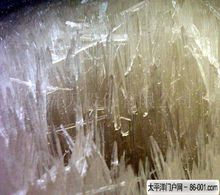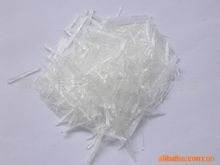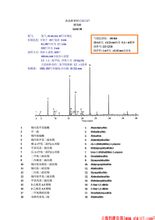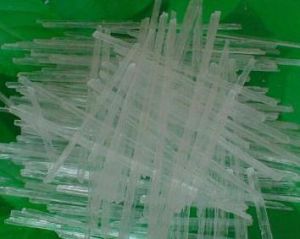薄荷醇介紹
 薄荷醇
薄荷醇一種萜,又稱薄荷腦。分子式CHO,左鏇薄荷醇為無色透明
針狀晶體;熔點44℃ ,沸點 216.4℃,比鏇光度 -48° ;微溶於水 ,溶於乙醇、乙醚 、丙酮、氯仿。 消鏇薄荷醇為無色透明針狀晶體;熔點 38℃, 沸點216℃; 溶於乙醇、乙醚、丙酮、苯。薄荷醇氫化生成對烷;用鉻酸氧化或催化脫氫得薄荷酮;消鏇薄荷醇可通過苯甲酸酯化法拆分。薄荷醇可從薄荷油分離得到,也可由香茅醛或百里酚製造。薄荷醇是一種重要香料。左鏇薄荷醇由於其清涼效果,大量用於香菸、化妝品、牙膏、口香糖、甜食和藥物、塗擦劑[發揮局部止癢、止痛、清涼(機理:刺激皮膚上的冷感受器但不導致實際溫度變化)及輕微局麻等作用,也起促滲透劑作用]中。合成薄荷醇是各種異構體的混合物,價值不大。
薄荷醇是在葉片裡製造的,也就是薄荷油的主要成分,是環類單萜的一種。是植物所產生的高揮發性精油,其成份多為半萜、單萜及倍半萜,尤其在氣候溫暖時產量更高。某些重要的植物色素是類萜或含類萜基的化合物。
植物來源
唇形科植物薄荷Mentho haplocalyx Bing)全草,金錢草Glechoma longituba(Nakai)Kupr.全草,尖紫蘇Perilla frutescens (L.)Britt.var .Acuto(Thunb.)Kudo葉.
分子式及分子量
CHO,156.27 [CAS NO.]:89-78-1
[物理性質]白色晶體
藥理作用
 薄荷醇
薄荷醇有止癢、止痛、防腐、刺激、麻醉、清涼和抗炎作用,可治頭痛、神經痛、瘙癢及呼
吸道炎症、萎縮性鼻炎、聲啞等.
[Herb source]: Mentho haplocalyx Bing
[Molecular Formula]: C10H20O,
[Molecular Weight]: 156.27
[Physics Properties]:white crystal
[Pharmacology function]: itching, pain relieving and anti-corrosion and stimulating, narcotic, cool and anti-inflammatory effects, to cure a headache, neuralgia, itching and respiratory inflammation, atrophic rhinitis, signs, etc.
檢驗
取本品葉粉末少許,經微量升華得油狀物,迅速加硫酸2滴及香草醛結晶少量,顯黃色至橙黃色,再加水1滴,即變紫紅色。(示薄荷醇)
貯藏
:密閉、避免高溫及強氧化劑。
 薄荷醇氣相色譜
薄荷醇氣相色譜薄荷醇;薄荷腦;[1R-(1α,2β,5α)]-5-甲基-2-(1-甲基乙基)環己醇;薄荷冰;萜醇-;對烷-3-醇;[1R-(1A,2B,5A)]-5-甲基-2-(1-甲基乙基);2-異丙基-5-甲基環己醇;l-menthol;(-)-menthol;(-)-menthyl alcohol;(1r,3r,4s)-(-)-menthol;(1r-(1-alpha,2-beta,5-alpha))-5-methyl-2-(1-methyl
ethyl)cyclohexanol;(l)-menthol;(r)-(-)-menthol
資料: CAS:2216-51-5
分子式: CHO
分子質量: 156.26
沸點: 212℃
熔點: 41-43℃
中文名稱: 薄荷醇;薄荷腦;[1R-(1α,2β,5α)]-5-甲基-2-(1-甲基乙基)環己醇;薄荷冰;萜醇-;對烷-3-醇;[1R-(1A,2B,5A)]-5-甲基-2-(1-甲基乙基);2-異丙基-5-甲基環己醇
英文名稱: l-menthol;(-)-menthol;(-)-menthyl alcohol;(1r,3r,4s)-(-)-menthol;(1r-(1-alpha,2-beta,5-alpha))-5-methyl-2-(1-methylethyl)cyclohexanol;(l)-menthol;(r)-(-)-menthol
性質
無色針狀結晶或粒狀。熔點41-43℃(42-45℃),沸點216.5℃,相對密度0.890(15/15℃),折光率1.458。易溶於醇;氯仿;醚;冰醋酸;液狀石蠟及石油醚,微溶於水。薄荷醇含有三個不對稱碳原子,已知四個空間順式和反式異構體,它們每個都有右鏇型;左鏇型以及消鏇型。左鏇薄荷醇具有特徵有薄荷香氣並有清涼的作用。消鏇薄荷醇([89-78-1])也有清涼作用,其它的異構體無清涼作用。
生產
薄荷醇可由天然薄荷原油提純也可用合成法製取。唇形科植物薄荷的地上部分(莖;枝;葉和花序)經水蒸氣蒸餾所得的精油稱薄荷原油,得油率為0.5-0.6。合成薄合腦的方法有多種。1.從香茅醛中製造 利用香茅醛易環化成異胡薄荷醇的性質,將右鏇香茅醛用酸催化劑(如矽膠)環化成左鏇異胡薄荷醇,分出左鏇異胡薄荷醇,氫化生成左鏇薄荷。其立體導師構體經熱裂解可部分地遭到轉變成右鏇香茅醛,再循環使用。2.從百里酚中製造 在間甲酚鋁存在,對間甲酚進行烷基化反應生成百里酚。經催化加氫得所有四對薄荷醇立體異構體(即消鏇薄荷醇;消鏇新薄荷醇;消鏇異薄荷醇和消鏇新異薄荷醇)。將其進行蒸餾,取消鏇薄荷醇餾分,製造酯後反覆重結晶,進行異構體的分離和光學拆分。分離出來的左鏇薄荷醇酯,經皂化後得薄荷腦。
薄荷醇是一種重要的香料,有多種生產方法:
①從薄荷油製造:將薄荷油冷凍後析出結晶,離心所得結晶用低沸溶劑重結晶得純左鏇薄荷醇。除去結晶後的母液仍含薄荷醇40%~50%,還含較大量的薄荷酮,經氫化轉變為左鏇薄荷醇和右鏇新薄荷醇的混合物。將酯的部分皂化,經結晶、蒸餾或製成其硼酸酯後分去薄荷油中的其他部分,可得到更多的左鏇薄荷醇。
②從香茅醛製造:利用香茅醛易環化成異胡薄荷醇的性質,將右鏇香茅醛用酸催化劑(如矽膠)環化成左鏇異胡薄荷醇,分出左鏇異胡薄荷醇,氫化生成左鏇薄荷醇。其立體異構體經熱裂解可部分再轉變成右鏇香茅醛,再循環使用。
③從百里酚製造:百里酚氫化得所有四對薄荷醇立體異構體
套用
常見套用
薄荷腦和消鏇薄荷腦均可用作牙膏、香水、飲料和糖果等的賦香劑。在醫藥上用作刺激藥,作用於皮膚或黏膜,有清涼止癢作用;內服可用於頭痛及鼻、咽、喉炎症等。其酯用於香料和藥物。在世界上,我國和巴西是主要的天然薄荷生產國,薄荷油的年產量均達到2000-3000t。
“清涼衛生棉”及其健康爭論
一些衛生棉品牌將薄荷醇等物質套用於衛生棉表面,開發出“清涼衛生棉”品種。利用此類物質的特性產生“清涼”感。但需要注意的是,敏感皮膚和過敏體質的女性,應當慎用添加香料和藥物成分的衛生棉,以免引起皮膚刺激和過敏反應。
針對“清涼衛生棉”,有流言稱其“破壞生殖器的弱酸環境,弱酸環境的破壞會使生殖器自身的抵抗能力下降!用了會讓月經量越來越少”。但這一說法並不可靠。原因包括:
1,“清涼衛生棉”破壞陰道弱酸環境的說法在理論上有可能成立,但實際中可能較小。陰道的微生態環境的平衡對外界微生物的侵入有一定防禦功能,稱為陰道的自淨作用。雌激素、陰道乳桿菌和陰道的弱酸性環境是構成陰道自淨能力的三個重要環節。對薄荷醇的研究表明,薄荷醇本身具有一定抑菌能力,理論上在一定用量之下可能導致陰道弱酸性環境的破壞。但在實際情況中,產生涼感所需的薄荷醇濃度遠小於其最低抑菌濃度,局部使用並實際進入陰道的薄荷醇難以產生抑菌效果。
2,“清涼衛生棉”也不會讓月經量越來越少。首先薄荷醇並沒有性激素的藥理作用,不會影響內分泌,也就不會對月經產生影響。其次,子宮和陰道是相對隔離的兩個環境,只在經期宮頸口會微微打開以便排出宮腔內產生的月經。因此能夠從衛生棉表面擴散進入宮腔的薄荷醇等化學物質微乎其微,不可能對宮內環境造成影響。
此外,包括“清涼衛生棉”在內的一些所謂的草本衛生棉會宣傳對女性有某些保健和治療作用,這一點也不可輕信。一方面,並沒有可靠的證據表明這些宣傳的功效是實際有效的;另一方面,由於皮膚的結構緻密,藥物吸收有限,就算是在其他方面證明有效的藥物,也不代表用在衛生棉上同樣有效。
注意
由於本品對皮膚以及眼睛有刺激作用以及一定的毒性,大量使用時必須戴好手套以及安全眼鏡。
[中毒急救措施]
1、吸入:將中毒著轉移至通風處,採取一般急救措施。
2、誤入眼睛:按一般步驟沖洗眼睛,有必要著請諮詢醫師。
3、皮膚接觸:用清水和肥皂清洗。
4、其他:諮詢醫師。
消鏇薄荷醇可用蒸餾法與其他三對異構體分開,剩下的異構體混合物在百里酚氫化條件下可平衡成消鏇薄荷醇、消鏇新薄荷醇、消鏇異薄荷醇,比例為 6:3:1,新異薄荷醇含量很少,可不計。從以上混合物可再分出消鏇薄荷醇。消鏇薄荷醇經苯甲酸酯飽和溶液或其超冷混合物以左鏇酯接種結晶,分開後皂化,得純左鏇薄荷醇;不要的右鏇薄荷醇及其他異構體,可再按氫化條件平衡轉變為消鏇薄荷醇。
相關外文文獻
下列為食品夥伴網上的關於薄荷醇(menthol)的英語資料。
Menthol is a terpenoid, found in the essential oils of the mint family (Mentha spp), such as peppermint, spearmint and others. Menthol (C10H20O) is solid at room temperature, forming long crystals that have a fatty touch. Several isomers of menthol exist, some with a menthol smell, others without. Normally occurring menthol, with the strongest smell, is (-)-menthol (lower left in figure below).
Structure of menthol and isomers
Menthol is not or poorly soluble in water, but readily soluble in alcohol or oils.
Besides the use as an aroma in many different food products (especially dental products, such as chewing gum, cough drops and confectionary, such as mints), menthol is contained in non-prescription products for short-term relief of minor sore throat and minor mouth or throat irritation, for example in lip balms and cough medicines. It is classed as an antipruritic, which reduces itching. Menthol is also contained in combination products used for relief of muscle aches, sprains, and similar conditions, as well as in decongestants. In addition, it is used as an additive in certain cigarette brands, both for flavour and to reduce the throat and sinus irritation caused by smoking. Menthol also is a common ingredient in mouthwash.
Menthol
From Wikipedia, the free encyclopedia
Jump to: navigation, search
Not to be confused with methanol.
Menthol
General
Systematic name 2-(2-Propyl)-5-
methylcyclohexanol
Stereochemical
configuration (2S,5R,1R)
Other names 3-p-Menthanol,
Hexahydrothymol,
Menthomenthol,
peppermint camphor
Molecular formula C10H20O
SMILES CC1CCC(C(C1)O)C(C)C
Molar mass 156.27 g·mol−1
Appearance White or colorless
crystalline solid
CAS number [89-78-1], racemic
[2216-51-5], (−)-isomer
Properties
Density and phase 0.890 g·cm−3, solid
(racemic or (−)-isomer)
Solubility in water Slightly soluble, (−)-isomer
In ethanol, diethyl ether,
acetone, chloroform
acetic acid, hexane Soluble
Melting point 36-38 °C (311 K), racemic
42-45 °C (318 K), (−)-form (α)
35-33-31 °C, (−)-isomer
Boiling point 212 °C (485 K)
Chiral rotation [α]D -50° at 18 °C, 10% in EtOH
Hazards
MSDS External MSDS
Main hazards Irritant, flammable
NFPA 704 210
Flash point 93 °C
R/S statement R37/38, R41 S26, S36
RTECS number OT0350000, racemic
OT0700000, (−)-enantiomer
Supplementary data page
Structure & properties n, εr, etc.
Thermodynamic data Phase behavior
Solid, liquid, gas
Spectral data UV, IR, NMR, MS
Related compounds
Related alcohols Cyclohexanol, Pulegol,
Dihydrocarveol, Piperitol
Related compounds Menthone, Menthene,
Thymol, p-Cymene,
Citronellal
Except where noted otherwise, data are given for
materials in their standard state (at 25 °C, 100 kPa)
Infobox disclaimer and references
Menthol is a covalent organic compound made synthetically or obtained from peppermint or other mint oils. It is a waxy, crystalline substance, clear or white in color, which is solid at room temperature and melts slightly above. The main form of menthol occurring in nature is (-)-menthol, which is assigned the (1R,2S,5R) configuration. Menthol has local anesthetic and counterirritant qualities, and it is widely used to relieve minor throat irritation.
Contents [hide]
1 History and occurrence
2 Structure
3 Applications
4 Synthesis
5 Natural menthol
6 Chemical properties
7 Biological properties
8 Notes
9 References
History and occurrence
There is evidence that menthol has been known in Japan for more than 2000 years, but in the West it was not isolated until 1771, by Gambius. (-)-Menthol (also called l-menthol or (1R,2S,5R)-menthol) occurs naturally in peppermint oil (along with a little menthone, the ester menthyl acetate and other compounds), obtained from mentha x piperita. Japanese menthol also contains a small percentage of the 1-epimer, (+)-neomenthol.
Structure
Natural menthol exists as one pure enantiomer, nearly always the (1R,2S,5R) form (bottom left of diagram below).
In the natural compound, the isopropyl group is oriented trans- orientation to both the methyl and alcohol groups.
In the ground state all three bulky groups in the chair are equatorial, making (-)-menthol and its enantiomer the most stable two isomers out of the eight.
There are two crystal forms for racemic menthol; these have melting points of 28 °C and 38 °C. Pure (-)-menthol has four crystal forms, of which the most stable is the α form, the familiar broad needles.
Applications
Menthol is included in many products for a variety of reasons. These include:
In non-prescription products for short-term relief of minor sore throat and minor mouth or throat irritation
Examples: lip balms and cough medicines
As an antipruritic to reduce itching
As a topical analgesic to relieve minor aches and pains such as muscle cramps, sprains, headaches and similar conditions, alone or combined with products like Camphor or Capsaicin. In Europe it tends to appear as a gel or a cream, while in the US patches and body sleeves are very frequently used
Examples: Tiger Balm IcyHot patches or knee/elbow sleeves
In decongestants for chest and sinuses (cream, patch or nose inhaler)
Examples: Vicks Vaporub
In certain medications used to treat sunburns, as it provides a cooling sensation (then often associated with Aloe)
As an additive in certain cigarette brands, for flavor, to reduce the throat and sinus irritation caused by smoking and arguably to reduce the bad-breath smokers experience and possibly improve the smell of second-hand smoke.
Commonly used in oral hygiene products and bad-breath remedies like mouthwash, toothpaste, mouth and tongue-spray, and more generally as a food flavor agent e.g. in chewing-gum, candy
In a soda as well as in a syrup to be mixed with water to obtain a very low alcohol drink or (brand Riclès in France). The syrup is/was also used to alleviate nausea, in particular motion sickness, by pouring a few drops on a lump of sugar.
As a pesticide against tracheal mites of honeybees
In perfumery, menthol is used to prepare menthyl esters to emphasise floral notes (especially rose)
In first aid products such as "mineral ice" to produce a cooling effect as a substitute for real ice in the absence of water or electricity (Pouch, Body patch/sleeve or cream)
In various patches ranging from fever-reducing patches applied to children's foreheads to "foot patches" to relieve numerous ailments (the latter being much more frequent and elaborate in Asia, esp. Japan: some variety use `functional protrusion' i.e. small bumps to massage ones feet as well as soothing them and cooling them down)
In some beauty products such as hair-conditioners, based on natural ingredients (ex: St Ives)
Some supporters of the homeopathic theory of pharmacology believe that menthol interferes with the effects of homeopathic remedies. Its use is strongly discouraged for those seeking homeopathic cures, to the point of prohibiting the use of mint-flavored toothpaste. Currently no other reported nutrient or herb interactions involve menthol. It is used in Eastern medicine to treat indigestion, nausea, sore throat, diarrhea, colds, and headaches. (-)-Menthol has low toxicity: Oral (rat) LD50: 3300 mg·kg−1; Skin (rabbit) LD50: 15800 mg·kg−1).
In organic chemistry, menthol is used as a chiral auxiliary in asymmetric synthesis. For example, sulfinate esters made from sulfinyl chlorides and menthol can be used to make enantiomerically pure sulfoxides by reaction with organolithium reagents or Grignard reagents. Menthol is also used for classical resolution of chiral carboxylic acids, via the menthyl esters.
Synthesis
As with many widely-used natural products, the demand for menthol greatly exceeds the supply from natural sources. Menthol is manufactured as a single enantiomer (94% ee) by Takasago International Co. on a scale of 400 000 tonnes per year. The process involves an asymmetric synthesis developed by a team led by Ryoji Noyori.
The process begins by forming an allylic amine from myrcene, which undergoes asymmetric isomerisation in the presence of a BINAP rhodium complex to give (after hydrolysis) enantiomerically pure R-citronellal. This is cyclised by a carbonyl-ene-reaction initiated by zinc bromide to isopulegol which is then hydrogenated to give pure (1R,2S,5R)-menthol.
Racemic menthol can be prepared simply by hydrogenation of thymol, and menthol is also formed by hydrogenation of pulegone. For preparation of other isomers such as neomenthol, see ref. 1.
Natural menthol
Mentha arvensis is the primary species of mint used to make natural menthol crystals and natural menthol flakes. This species is primarily grown in the Uttar Pradesh region in India.
Chemical properties
Menthol reacts in many ways like a normal secondary alcohol. It is oxidised to menthone by oxidising agents such as chromic acid, though under some conditions the oxidation can go further and break open the ring. Menthol is easily dehydrated to give mainly 3-menthene, by the action of 2% sulfuric acid. PCl5 gives menthyl chloride.
Biological properties
Menthol's ability to chemically trigger cold-sensitive receptors in the skin is responsible for the well known cooling sensation that it provokes when inhaled, eaten, or applied to the skin. Menthol does not cause an actual drop in temperature. In this sense it is similar to capsaicin, the chemical responsible for the spiciness of hot peppers (which stimulates heat sensors, also without causing actual temperature rise).
Notes
^ J. L. Simonsen, The Terpenes Volume I (2nd edition), Cambridge University Press, 1947, p230-249.
^ Adversoriorum varii argumentii, Liber unus, Leiden, 1771, p99.
^ R. Eccles, Menthol and Related Cooling Compounds, Journal of Pharm. Pharmacol. 1994 46: 618-630
References
E. E. Turner, M. M. Harris, Organic Chemistry, Longmans, Green & Co., London, 1952.
Handbook of Chemistry and Physics, 71st edition, CRC Press, Ann Arbor, Michigan, 1990.
The Merck Index, 7th edition, Merck & Co, Rahway, New Jersey, USA, 1960.

